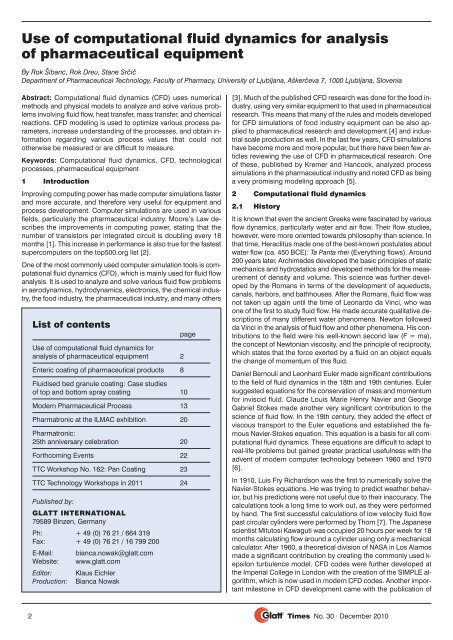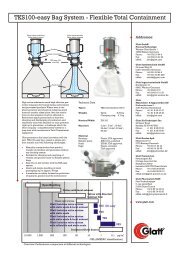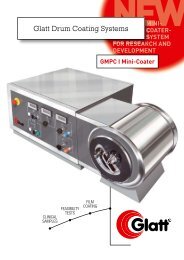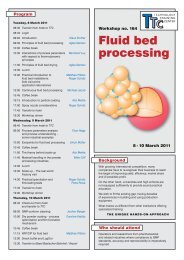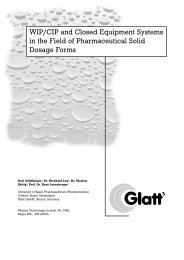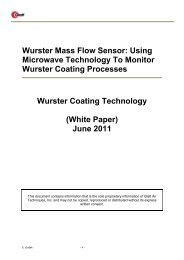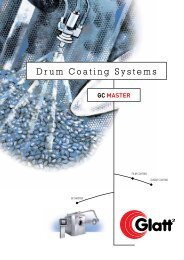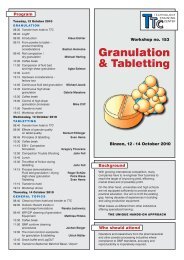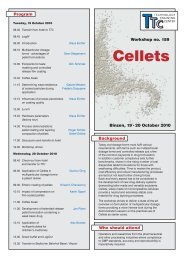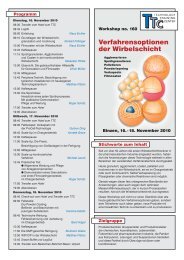No. 30 - Glatt
No. 30 - Glatt
No. 30 - Glatt
Create successful ePaper yourself
Turn your PDF publications into a flip-book with our unique Google optimized e-Paper software.
Use of computational fluid dynamics for analysis<br />
of pharmaceutical equipment<br />
By Rok Šibanc, Rok Dreu, Stane Srčič<br />
Department of Pharmaceutical Technology, Faculty of Pharmacy, University of Ljubljana, Aškerčeva 7, 1000 Ljubljana, Slovenia<br />
Abstract: Computational fluid dynamics (CFD) uses numerical<br />
methods and physical models to analyze and solve various problems<br />
involving fluid flow, heat transfer, mass transfer, and chemical<br />
reactions. CFD modeling is used to optimize various process parameters,<br />
increase understanding of the processes, and obtain information<br />
regarding various process values that could not<br />
otherwise be measured or are difficult to measure.<br />
Keywords: Computational fluid dynamics, CFD, technological<br />
processes, pharmaceutical equipment<br />
1 Introduction<br />
Improving computing power has made computer simulations faster<br />
and more accurate, and therefore very useful for equipment and<br />
process development. Computer simulations are used in various<br />
fields, particularly the pharmaceutical industry. Moore’s Law describes<br />
the improvements in computing power, stating that the<br />
number of transistors per integrated circuit is doubling every 18<br />
months [1]. This increase in performance is also true for the fastest<br />
supercomputers on the top500.org list [2].<br />
One of the most commonly used computer simulation tools is computational<br />
fluid dynamics (CFD), which is mainly used for fluid flow<br />
analysis. It is used to analyze and solve various fluid flow problems<br />
in aerodynamics, hydrodynamics, electronics, the chemical industry,<br />
the food industry, the pharmaceutical industry, and many others<br />
2<br />
List of contents<br />
Use of computational fluid dynamics for<br />
analysis of pharmaceutical equipment 2<br />
Enteric coating of pharmaceutical products 8<br />
page<br />
Fluidised bed granule coating: Case studies<br />
of top and bottom spray coating 10<br />
Modern Pharmaceutical Process 13<br />
Pharmatronic at the ILMAC exhibition 20<br />
Pharmatronic:<br />
25th anniversary celebration 20<br />
Forthcoming Events 22<br />
TTC Workshop <strong>No</strong>. 162: Pan Coating 23<br />
TTC Technology Workshops in 2011 24<br />
Published by:<br />
GLATT INTERNATIONAL<br />
79589 Binzen, Germany<br />
Ph: + 49 (0) 76 21 / 664 319<br />
Fax: + 49 (0) 76 21 / 16 799 200<br />
E-Mail: bianca.nowak@glatt.com<br />
Website: www.glatt.com<br />
Editor: Klaus Eichler<br />
Production: Bianca <strong>No</strong>wak<br />
[3]. Much of the published CFD research was done for the food industry,<br />
using very similar equipment to that used in pharmaceutical<br />
research. This means that many of the rules and models developed<br />
for CFD simulations of food industry equipment can be also applied<br />
to pharmaceutical research and development [4] and industrial<br />
scale production as well. In the last few years, CFD simulations<br />
have become more and more popular, but there have been few articles<br />
reviewing the use of CFD in pharmaceutical research. One<br />
of these, published by Kremer and Hancock, analyzed process<br />
simulations in the pharmaceutical industry and noted CFD as being<br />
a very promising modeling approach [5].<br />
2 Computational fluid dynamics<br />
2.1 History<br />
It is known that even the ancient Greeks were fascinated by various<br />
flow dynamics, particularly water and air flow. Their flow studies,<br />
however, were more oriented towards philosophy than science. In<br />
that time, Heraclitus made one of the best-known postulates about<br />
water flow (ca. 450 BCE): Ta Panta rhei (Everything flows). Around<br />
200 years later, Archimedes developed the basic principles of static<br />
mechanics and hydrostatics and developed methods for the measurement<br />
of density and volume. This science was further developed<br />
by the Romans in terms of the development of aqueducts,<br />
canals, harbors, and bathhouses. After the Romans, fluid flow was<br />
not taken up again until the time of Leonardo da Vinci, who was<br />
one of the first to study fluid flow. He made accurate qualitative descriptions<br />
of many different water phenomena. Newton followed<br />
da Vinci in the analysis of fluid flow and other phenomena. His contributions<br />
to the field were his well-known second law (F = ma),<br />
the concept of Newtonian viscosity, and the principle of reciprocity,<br />
which states that the force exerted by a fluid on an object equals<br />
the change of momentum of this fluid.<br />
Daniel Bernouli and Leonhard Euler made significant contributions<br />
to the field of fluid dynamics in the 18th and 19th centuries. Euler<br />
suggested equations for the conservation of mass and momentum<br />
for inviscid fluid. Claude Louis Marie Henry Navier and George<br />
Gabriel Stokes made another very significant contribution to the<br />
science of fluid flow. In the 19th century, they added the effect of<br />
viscous transport to the Euler equations and established the famous<br />
Navier-Stokes equation. This equation is a basis for all computational<br />
fluid dynamics. These equations are difficult to adapt to<br />
real-life problems but gained greater practical usefulness with the<br />
advent of modern computer technology between 1960 and 1970<br />
[6].<br />
In 1910, Luis Fry Richardson was the first to numerically solve the<br />
Navier-Stokes equations. He was trying to predict weather behavior,<br />
but his predictions were not useful due to their inaccuracy. The<br />
calculations took a long time to work out, as they were performed<br />
by hand. The first successful calculations of low velocity fluid flow<br />
past circular cylinders were performed by Thom [7]. The Japanese<br />
scientist Mitutosi Kawaguti was occupied 20 hours per week for 18<br />
months calculating flow around a cylinder using only a mechanical<br />
calculator. After 1960, a theoretical division of NASA in Los Alamos<br />
made a significant contribution by creating the commonly used kepsilon<br />
turbulence model. CFD codes were further developed at<br />
the Imperial College in London with the creation of the SIMPLE algorithm,<br />
which is now used in modern CFD codes. Another important<br />
milestone in CFD development came with the publication of<br />
Times <strong>No</strong>. <strong>30</strong> · December 2010


